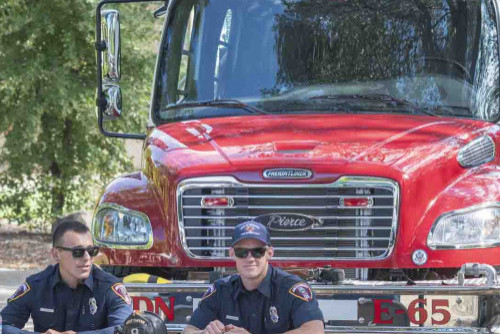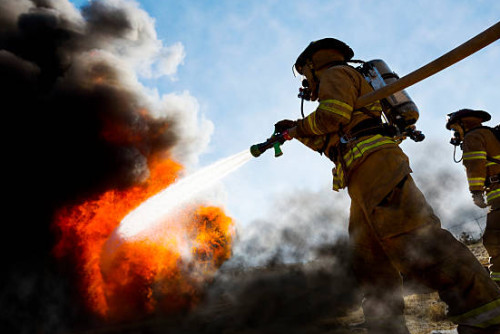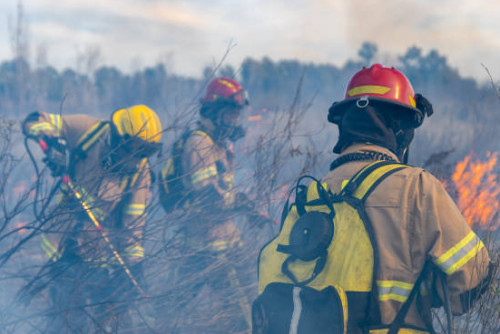General Studies: Fire – Wildland Fire Behavior AS Degree
General Studies – 18 Unit Emphasis | SC Program: AS.1509
While available to anyone, this degree is designed for students who have been working as wildland firefighters and intend on working within the Plans Section of the Incident Command System (specifically the Situation Unit and Fire Behavior positions). Once a student has completed this degree, it is hoped that they will continue their education and pursue a transfer level AA degree with a final target being undergraduate and graduate degrees in Meteorology, Physics, or similar disciplines.



Choose your path
Map your education by viewing the program map for the degree or certificate you’re interested in earning below. Meet with a counselor to create your official comprehensive education plan.
A program map shows all the required and recommended courses you need to graduate and a suggested order in which you should take them. The suggested sequence of courses is based on enrollment and includes all major and general education courses required for the degree.
Fall Semester, First Year
21 Units TotalNotes:
1. The California State Fire Marshal's Office requires that all Firefighter I summative tests be completed with a minimum score of 80% (a grade of B or higher). Any student who does not meet this standard will have failed FIRS 104 and will not receive credit for the course.
2. Any student enrolling in FIRS 104 must have completed the prerequisites of FAID 132 or FAID 332 at Shasta College (or their equivalents at another institution), OR FAID 75 at Shasta College (or the equivalents at another institution). Students who attempt to satisfy these prerequisites with courses from another institution must provide transcripts that verify a minimum grade of B (80%) has been met.
This course provides the skills and knowledge needed for the entry level professional fire fighter to perform his/her duties safely, effectively, and competently. The curriculum is based on the current edition of NFPA 1001 Standard for Fire Fighter Professional Qualifications, the current edition of NFPA 1051 Standard for Wildland Fire Fighter Professional Qualifications, and the current edition of NFPA 472 Standard for Competence of Responders to Hazardous Materials/Weapons of Mass Destruction Incidents. The overarching themes of the California Office of the State Fire Marshal (OSFM) Fire Fighter 1 and 2 curriculum are: general knowledge germane to the profession, fire department communications, fireground operations, rescue operations, preparedness and maintenance, wildland suppression activities, flammable liquids and gas fire fighting, and hazardous materials/WMD. This academy is an Accredited Regional Training Program approved by the California State Board of Fire Services. Final certification as an IFSAC/Pro Board certified Fire Fighter 1 is achieved upon successful completion of the California Office of the State Fire Marshal's manipulative and cognitive testing for Fire Fighter 1. Certification as an OSFM Fire Fighter 2 is achieved upon successful completion of the California Office of the State Fire Marshal's manipulative and cognitive testing for Fire Fighter 2, and is verified by the Office of the State Fire Marshal after the student completes the Academy and works as a volunteer Fire Fighter for one year or a full-time paid Fire Fighter for six months. Students successfully completing this course will receive numerous standalone certificates in structure and wildland fire suppression; Auto Extrication, Confined Space Awareness, Hazardous Materials Operations (Pro Board), and others. Note: This course meets five days a week with occasional night classes, and additional weekend days as required. Preset/scheduled dates and times may be shifted as needed to accommodate facility usage, equipment demands, weather, skills development needs and instructor availability. When dates and times are shifted, the total amount of required class time will not differ from those hours as listed on the first class handout.
Spring Semester, First Year
14 Units TotalThis course applies the principles of ethical and effective communication to the creation of letters, memos, emails, and written and oral reports for a variety of business situations. The course emphasizes planning, organizing, composing, and revising business documents using word processing software for written documents and presentation-graphics software to create and deliver professional-level oral reports. This course is designed for students who already have college-level writing skills. This is a required course for many major and certificate programs and an alternate requirement or suggested elective in others. This class also satisfies the A.S. General Education requirement in English. This course may be offered in a distance education format.
This course provides an introduction to psychology, the study of the mind and behavior, as a science and as an applied field. The course provides an integration of physiological, cognitive, social-behavioral, psychodynamic, humanistic, cultural, and evolutionary perspectives. Topics include research methods, the nervous system, perception, learning, thinking, memory, human development, social behavior, emotions, motivation, personality, abnormal behavior, and psychotherapy. This course may be offered in a distance education format.
Fall Semester, Second Year
14 Units TotalThis course is a survey of the history of the United States from Pre-Columbian Peoples to the end of Reconstruction. Topics include contact and settlement of America, the movement toward independence, the formation of a new nation and Constitution, westward expansion and manifest destiny, the causes and consequences of the Civil War, and Reconstruction. This course satisfies the CSU requirement for US History (US-1). This course may be offered in a distance education format.
1. While any student can take this course, for National Wildfire Coordinating Group Certification, the student must meet a complex set of prior training, prior certification, field trainee assignments, previous education requirements and current employees recommendations for certification (as stated in the NWCG 310-1 standards). This document changes frequently. Students shall ensure that they meet the current NWCG 310-1 standards for this course if they desire to receive a course completion certificate. A copy of NWCG 310-1 can be found in the Fire Technology Division Office or at the National Interagency Fire Center Web Site (NIFC.gov).
2. This course may be repeated any number of times for credit by persons who are legally mandated to meet training requirements as a condition of continued paid or volunteer employment.
This is a classroom-based skills course designed to prepare the prospective fireline supervisor to undertake safe and effective fire management operations. It is the second course in a series that collectively serves to develop fire behavior prediction knowledge and skills. Fire environment differences are discussed as necessary and should include local conditions affecting fire behavior.
Dynamic aspects of the atmosphere responsible for climate and weather represent the main focus of this course. Topics include atmospheric composition, solar radiation, global heat transfer, atmospheric moisture, pressure and atmospheric circulation, air masses, weather patterns and forecasting, storms including hurricanes and tornadoes, air pollution and ozone, and global climate changes. Applicable fundamental science concepts such as state changes, heat transfer mechanisms, and the physical and chemical aspects of the media involved in weather are also introduced. Further the course will consider influences on the atmosphere that disrupt sustainable, stable climate conditions. This course may be offered in a distance education format.
Spring Semester, Second Year
12.5 Units TotalThis course is a comparative survey of the major ancient world civilizations which developed between 3500 B.C.E. and 1500 C.E. It examines political institutions, religious ideologies, the rise and fall of empires, and the major cultural innovations of each of the major world civilizations. This course may be offered in a distance education format.
This course is a survey of inorganic chemistry and some organic chemistry suitable for agriculture and nursing students. The basic fundamentals of the metric system, chemical nomenclature, atomic and molecular structure, chemical reactions, energy changes, states of matter, solutions, chemical equilibria and kinetics, and organic functional groups are presented. The quantitative nature of chemistry is developed by introduction of the Avogadro's number and the mole and continuing with stoichiometry, gas law, solution concentrations, and pH calculations. The lecture/discussion portion of this course may be offered in a distance learning format.
This course presents the experienced wildland firefighter with the necessary skills to function as a Field Observer on a wildland fire incident. This course presents an understanding of the various types of maps used in wildland fire control, map scale and use in determining location of wildland fire, topographic maps and how to use them, and calculations to determine the size of a fire on a map.
Please see a counselor to discuss options for meeting general education requirements for transfer to California State Universities (CSU) and/or University of California (UC) campuses, as well as any specific additional courses that may be required by your chosen institution of transfer.
*Alternative Courses: Please see a Shasta College counselor for alternative course options. You can also view the following to find other courses to meet degree/certificate requirements:
- California State Universities – General Education
- IGETC – Intersegmental General Education Transfer Curriculum
Need a print out? Feel free to download and/or print out a copy of the sample program map(s).
- General Studies: Fire – Wildland Fire Behavior AS Degree (PDF)
*These printouts are currently not yet available, but they will be linked as soon as they're ready!
Contact Us for More Information
Counseling & Student Services
Contact InfoAcademic/Instructional Division Office
Start Your Future at Shasta College
We are dedicated to helping you reach your educational and career goals. To begin your journey, apply for admissions today!
